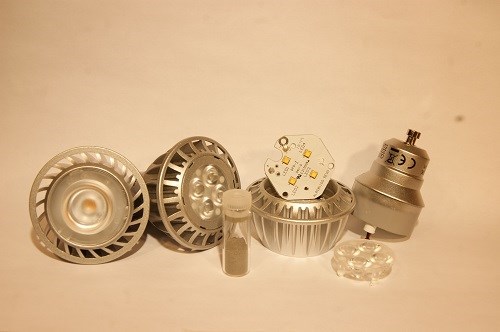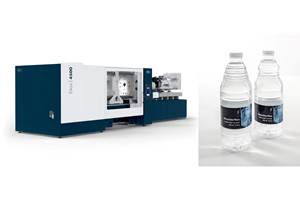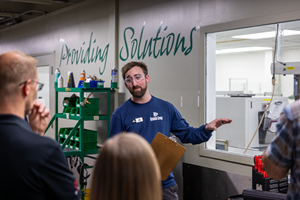Carbodeon Granted U.S. Patent for Nanodiamond-Containing Plastics
With thermally conductive plastics rapidly growing in demand, the addition of nanodiamonds to the arsenal of thermally-conductive fillers is only welcome.

Finland’s Carbodeon has been granted a U.S. patent for its technology which enables detonation-synthesized diamond particles –nanodiamonds (ND)—to be combined with polymers for use in fields such as consumer electronics, LED lighting, automotive and machine tools. The earth’s hardest natural mineral is also one of the most thermally conductive materials known, so when NDs are mixed in with thermoplastics in controlled amounts, they can enable plastics to conduct heat at pre-determined rates, and/or to be highly wear-resistant.
As we reported last year, the company is selling its ultra-dispersed” uDiamond ND fillers via U.S. representative SiliconSense of Nashua, N.H. Available in powder or liquid dispersions, the ND is reportedly fully dispersed into its primary particles without agglomeration. As such, the compounder and end-user can benefit from the entire available ND surface area, resulting in better performance with less material and cost.
ND-impregnated polymers can deliver heat-conducting benefits for products such as LED lighting, mobile devices including cellphones and Internet-of-Things (loT) enabled devices of any type. The hard wearing properties also make them ideally suited for use in the automotive and aerospace sectors to enable longer product life in hard-wear environments.
Carbodeon’s U.S. patent #9085723 is on the company’s developed nanodiamond containing thermoplastic thermally-conductive composites. The patent was filed after the company’s own developments during 2012-2013 whereby they discovered that the thermal conductivity of thermoplastics can be significantly enhanced by adding nanodiamonds, usually is relatively small quantities (e.g., 0.1%). Since filling the patent, Carbodeon has continued their own research as well as developing the range of commercial applications of the technology.
Said company CTO Vesa Myllmaki, “The granting of this patent represents a key part of our nanodiamond composite material portfolio. The combined coverage of our filed and granted patents will secure our position and that of our customers in several nanodiamond applications including polymers for thermal management applications, wear- and corrosion-resistant nanodiamond metal finishing, and wear-resistant/low-friction nanodiamond fluroropolymer coatings.”
A recently-released report, “Thermally Conductive Plastics Market by Raw Material, by End-Use Industry—Global Trends and Forecast to 2020”, by India’s market research firm Markets and Markets, projects a 14.3% annual growth of thermally conductive plastics over the 2015-2020 period. The report notes that thermally conductive plastics are used in a broad range of industries including electrical & electronics, automotive, industrial, healthcare, and aerospace. In 2015, the electrical & electronics segment accounted for the largest market share among all the end-use industries in terms of volume, followed by automotive, industrial, and healthcare. Among all the end-use industries, healthcare is estimated to grow at the highest annual rate.
Another interesting tidbit from this study is that rising demand from North America is the major driver for thermally conductive plastics. In 2015, North America is estimated to account for the largest market share in terms of volume, and is estimated to remain the market leader in the next five years. The use of shale gas as raw material for producing polymers has lowered the price of thermally conductive plastics and is boosting demand in this region. Within the last two years, the U.S. led the demand for thermally conductive plastics due to increased demand of LED lighting. Markets in emerging economies, such as Mexico, China, and India are projected to grow very rapidly.
Key companies profiled by this study are: BASF, Covestro, Saint Gobain, Toray Industries, DSM, Hella KGaA Hueck & Co., RTP Company, Celanese Corp., Polyone Corp., Kaneka Corp., and Mistubishi Engineering-Plastics.
Related Content
Krones Acquires Netstal
Krones adds PET preform injection molding to its bottle blowing and filling capabilities, as well as cap molding and expansion into medical, food and other markets.
Read MoreWhat to Look for in High-Speed Automation for Pipette Production
Automation is a must-have for molders of pipettes. Make sure your supplier provides assurances of throughput and output, manpower utilization, floor space consumption and payback period.
Read MoreMedical Molder, Moldmaker Embraces Continuous Improvement
True to the adjective in its name, Dynamic Group has been characterized by constant change, activity and progress over its nearly five decades as a medical molder and moldmaker.
Read MoreCompact Solution for Two-Component Molding
Zahoransky’s new internal mold handling technology foregoes the time, space and money required for core-back, rotary table or index plate technologies for 2K molding.
Read MoreRead Next
People 4.0 – How to Get Buy-In from Your Staff for Industry 4.0 Systems
Implementing a production monitoring system as the foundation of a ‘smart factory’ is about integrating people with new technology as much as it is about integrating machines and computers. Here are tips from a company that has gone through the process.
Read MoreMaking the Circular Economy a Reality
Driven by brand owner demands and new worldwide legislation, the entire supply chain is working toward the shift to circularity, with some evidence the circular economy has already begun.
Read MoreBeyond Prototypes: 8 Ways the Plastics Industry Is Using 3D Printing
Plastics processors are finding applications for 3D printing around the plant and across the supply chain. Here are 8 examples to look for at NPE2024.
Read More


























